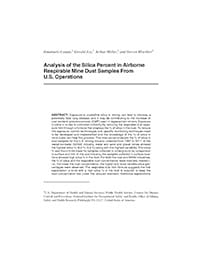Mining Publication: Analysis of the Silica Percent in Airborne Respirable Mine Dust Samples from U.S. Operations
Original creation date: February 2014
Authors: E Cauda, G Joy, AL Miller, SE Mischler
NIOSHTIC2 Number: 20044087
Silica and associated respirable mineral particles. Harper M, Lee T, eds. West Conshohocken, PA: ASTM International, STP 1565, 2014 Feb; :12-27
Exposure to crystalline silica in mining can lead to silicosis, a potentially fatal lung disease, and it may be contributing to the increase of coal workers' pneumoconiosis (CWP) seen in Appalachian miners. Exposure to silica in mines is controlled indirectly by reducing the respirable dust exposure limit through a formula that employs the % of silica in the dust. To reduce this exposure, control technologies and specific monitoring techniques need to be developed and implemented and the knowledge of the % of silica in mine dusts can help this process. This manuscript analyzes the % of silica in dust samples for the U.S. mining industry collected from 1997 to 2011. In the metal/nonmetal (M/NM) industry, metal and sand and gravel mines showed the highest silica % (8.2%, 9.8%) along with the highest variability. The silica % was found to be lower for samples collected in underground by comparison to surface and mill. In the coal industry, the samples collected in surface locations showed high silica % in the dust. For both the coal and M/NM industries, the % of silica and the respirable dust concentration were inversely related - i.e., the lower the dust concentration, the higher and more variable silica percentages were observed. The respirable dust limit formula suggests the first explanation: a mine with a high silica % in the dust is required to keep the dust concentration low under the reduced standard. Additional explanations are also proposed: the variability of the % of silica in the dust, the selective efficiency of control technologies, and different transport properties for dust with variable silica content. The findings improve the understanding of exposure to silica in mining environments and the data presented will be helpful in developing monitoring strategies for the measurement of silica and for the design of control technologies.

NIOSHTIC2 Number: 20044087
Silica and associated respirable mineral particles. Harper M, Lee T, eds. West Conshohocken, PA: ASTM International, STP 1565, 2014 Feb; :12-27
- Control of Respirable Dust
- The Effects of Low Quartz Mass Loading and Spatial Variability on the Quartz Analysis of Surface Coal Mine Dust Samples
- Exposure Monitoring of Dust and Toxic Substances
- Improving Silica Dust Control Through Targeted Research
- Laboratory Evaluation of a Canopy Air Curtain for Controlling Occupational Exposures of Roof Bolters
- Performance of a Light Scattering Dust Monitor at Various Air Velocities: Results of Sampling in the Active Versus the Passive Mode
- Reducing Enclosed Cab Drill Operator's Respirable Dust Exposure at Surface Coal Operation With a Retrofitted Filtration and Pressurization System
- Reducing Silica and other Respirable Hazards in the Industrial Minerals and Metal/Nonmetal Mining Industries
- Respirable Dust
- Respirable Quartz Hazard Associated with Coal Mine Roof Bolter Dust
- Using Real-Time Respirable Dust Monitors to Address the Silica Health Hazard in Mining